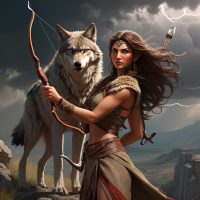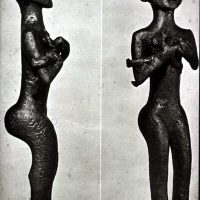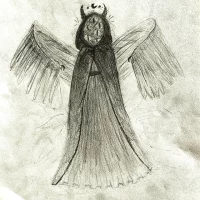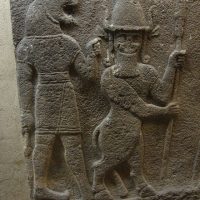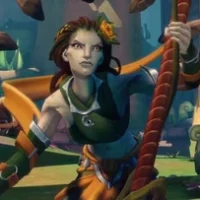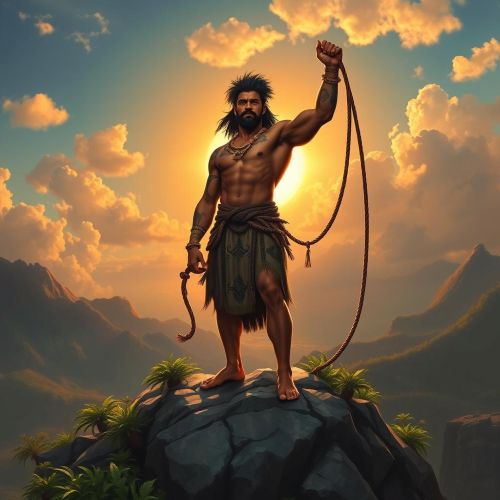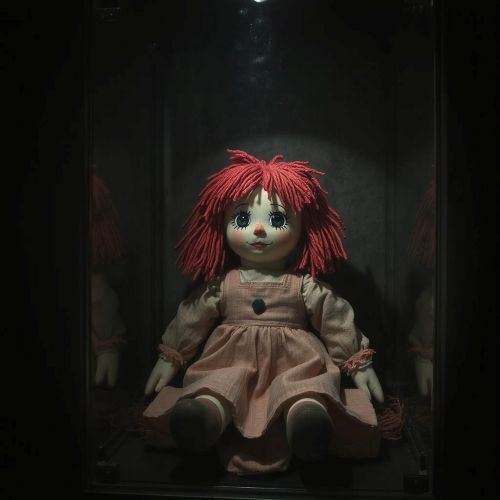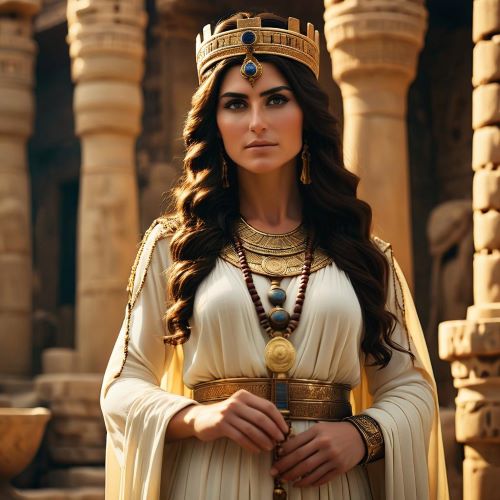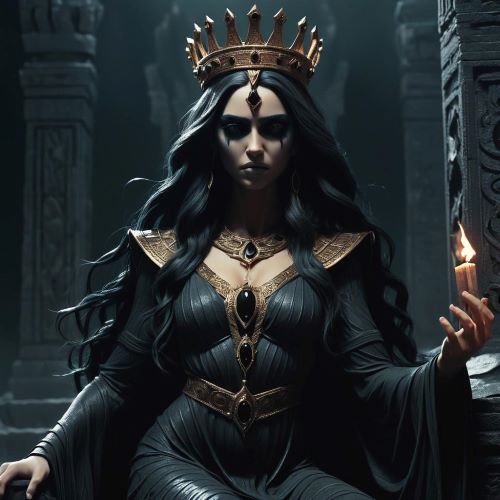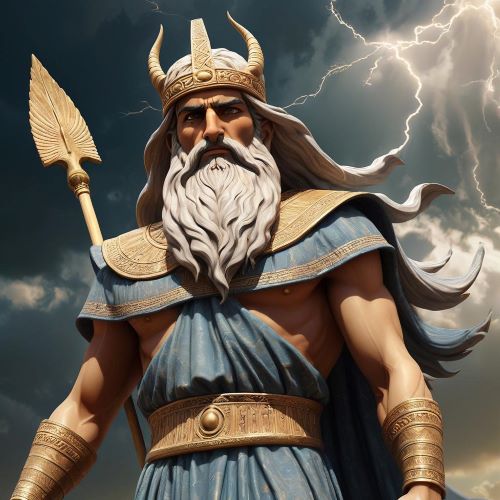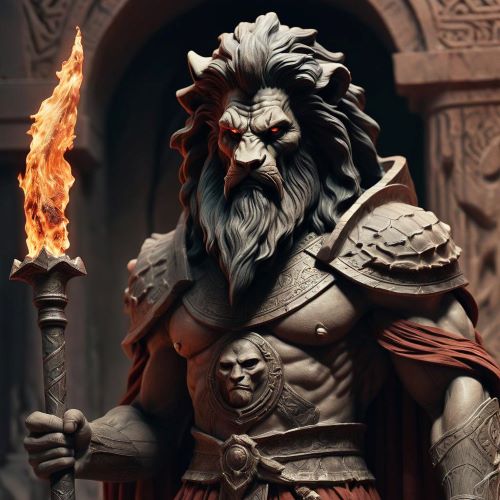Inara : Goddess of the Hunt
Listen
At a glance
| Description | |
|---|---|
| Origin | Hittite Mythology |
| Classification | Gods |
| Family Members | Teshub (Father). Hebat (Mother), Sarruma (Brother) |
| Region | Turkey |
| Associated With | Hunting, Killing Monsters |
Inara
Introduction
In the vast expanse of ancient mythologies, the Hittite civilization of Anatolia boasts a rich pantheon of deities. Among them stands Inara, the captivating embodiment of love, fertility, and sovereignty. Revered by the Hittite people, her myths provide a window into Anatolia’s cultural landscape. In the epic tale of the serpent Illuyanka, Inara emerges as a resourceful strategist and protector of the natural world, showcasing her significance in Hittite mythology. Known as the goddess of wild animals and the untamed steppe, Inara is the daughter of the Storm-god Teshub/Tarhunt. She parallels the Greek “potnia theron,” also known as Artemis, highlighting her enduring influence across cultures.
Physical Traits
Although specific physical traits of Inara remain elusive in the sources, her association with wild animals suggests depictions adorned with fauna or within wildlife-rich settings. In many ancient mythologies, deities linked to animals often bear animalistic attributes, yet no definitive descriptions of Inara’s appearance exist in Hittite texts. Nevertheless, portrayed with grace and elegance, Inara is commonly imagined as a radiant figure draped in regal attire, as reflected in ancient Hittite art. Her divine status is symbolized through flowing robes, while her countenance radiates beauty and tranquility, indicative of her domains of love and fertility.
Often depicted surrounded by symbols of abundance like blooming flowers or ripe fruits, her portrayal underscores her intimate connection to nature’s cycles. Speculatively, drawing parallels with Artemis, the Greek goddess of the hunt, Inara might have been envisaged as strong, agile, and skilled in archery, given her analogous role. Given Hittite art’s influence on Greek styles, similarities in depiction are plausible. Another conjecture arises from her association with wild creatures, suggesting possible adornments such as feathered crowns or eyes reminiscent of predatory felines.
Family
Inara’s familial connections within the Hittite pantheon underscore her significance in their mythology. As the daughter of the prominent sky god, Teshub (also known as Tarhunt), and potentially the mother goddess Hebat, Inara’s lineage places her at the heart of their divine hierarchy. Alongside her brother, the storm god Sarruma, and her sister, the sun goddess Arinnitti, Inara’s familial bonds weave her into the intricate tapestry of Hittite gods. Teshub, renowned for wielding the power of thunder and lightning, played a central role in ensuring the fertility of the land through vital rainfall—a connection that resonates with Inara’s potential influence over fertility and the natural world. While Inara’s mother remains unnamed in Hittite texts, scholars speculate a possible link to the Hurrian goddess Hannahannah, who shares associations with storms, fertility, and the hunt—a testament to the complex interplay of cultural influences within Anatolia.
Other names
In addition to being known as Inaras, Inara is also referenced in Greek mythology as the “potnia theron,” a title shared with the goddess Artemis, signifying her as the “Mistress of the Animals.” The etymology of the name Inara is noteworthy, stemming from the Hittite term “innara-,” meaning “power” or “strength,” reinforcing her portrayal as a formidable huntress and a resilient daughter of the storm god. Interestingly, in the Luwian language, Inara is alternatively referred to as Annari, showcasing the interconnectedness of ancient cultures and their shared pantheon. In Hurrian mythology, she is identified as Hannahannah, underscoring her associations with motherhood and fertility. This multiplicity of names across various regions and epochs reflects the diverse cultural influences that shaped the mythology of the ancient Near East, highlighting Inara’s enduring significance across civilizations.
Powers and Abilities
Inara’s powers as a goddess of love and fertility are intricately intertwined with the natural world, extending beyond mere abundance to encompass sovereignty and divine justice. In her portrayal as a warrior goddess, she aids her father, Teshub, in battles against cosmic chaos, showcasing her multifaceted influence. Notably, her strategic brilliance shines through in the epic confrontation with the monstrous serpent Illuyanka. Craftily devising a plan to vanquish the beast after it overwhelms Teshub, Inara’s resourcefulness and intelligence take center stage.
Her affiliation with the hunt suggests adeptness in weaponry, particularly archery, while her dominion over the wild implies a potential ability to command animals, leveraging them in hunts or calling upon their aid when necessary. The narrative of Illuyanka further hints at her possible mastery of magic or trickery, as evidenced by her use of a lavish feast to incapacitate the serpent—a testament to her understanding of deception, valuable in both hunting and warfare. Inara’s legend as the controller and protector of the wild animals of the steppe solidifies her dominion, while her pivotal role in the defeat of Illuyanka underscores her significance in preserving the cosmic order.
The tale of Inara finds its most vivid expression in the epic of Illuyanka, where a fearsome serpent vanquishes the storm god Teshub, plunging the world into disarray. In response, Inara orchestrates a cunning scheme to ensnare and conquer the beast. Seeking the aid of a mortal named Hupasiyas, she promises him a reward in exchange for his assistance, and he, swayed by her charm, agrees.
Inara meticulously arranges a lavish feast, likely tied to the Purulli festival, a Hittite celebration synonymous with fertility and rebirth. The unsuspecting Illuyanka and its offspring indulge in the bountiful spread, soon succumbing to lethargy and inebriation. Seizing the opportune moment, Hupasiyas binds the serpent, enabling Teshub to deliver the decisive blow and restore equilibrium to the cosmos.
This myth unravels the layers of Inara’s character, portraying her as a masterful strategist capable of outwitting seemingly insurmountable adversaries. Moreover, her collaboration with a mortal underscores her pragmatism and ingenuity. The narrative also hints at Inara’s potential association with fertility, as evidenced by the pivotal role of the Purulli festival in her scheme.
Modern Day Influence
While not as ubiquitous as Greek or Norse mythology, the influence of Inara and Hittite mythology persists in modern times, enriching the tapestry of ancient world lore. These myths, including those featuring Inara, offer invaluable glimpses into the beliefs and values of the Hittite civilization. For instance, the enduring tale of Inara and Illuyanka embodies a timeless narrative of chaos conquered, preserving the cosmic order.
Across millennia, Inara’s legacy resonates in contemporary society. Her portrayal as a goddess of love and fertility transcends time, finding expression in literature, art, and cultural traditions that celebrate life’s renewal and bonds of affection. Furthermore, the themes of sovereignty and justice associated with Inara echo in modern discourse on governance and ethical principles, reflecting the enduring relevance of Hittite mythology in shaping human understanding and imagination.
Related Images
Frequently Asked Questions
What is lorem Ipsum?
I am text block. Click edit button to change this text. Lorem ipsum dolor sit amet, consectetur adipiscing elit. Ut elit tellus, luctus nec ullamcorper mattis, pulvinar dapibus leo.
What is lorem Ipsum?
I am text block. Click edit button to change this text. Lorem ipsum dolor sit amet, consectetur adipiscing elit. Ut elit tellus, luctus nec ullamcorper mattis, pulvinar dapibus leo.
What is lorem Ipsum?
I am text block. Click edit button to change this text. Lorem ipsum dolor sit amet, consectetur adipiscing elit. Ut elit tellus, luctus nec ullamcorper mattis, pulvinar dapibus leo.
What is lorem Ipsum?
I am text block. Click edit button to change this text. Lorem ipsum dolor sit amet, consectetur adipiscing elit. Ut elit tellus, luctus nec ullamcorper mattis, pulvinar dapibus leo.
What is lorem Ipsum?
I am text block. Click edit button to change this text. Lorem ipsum dolor sit amet, consectetur adipiscing elit. Ut elit tellus, luctus nec ullamcorper mattis, pulvinar dapibus leo.

